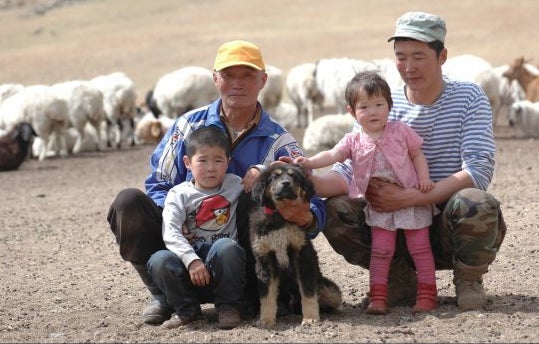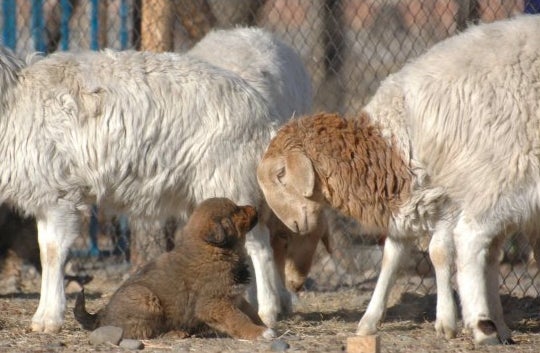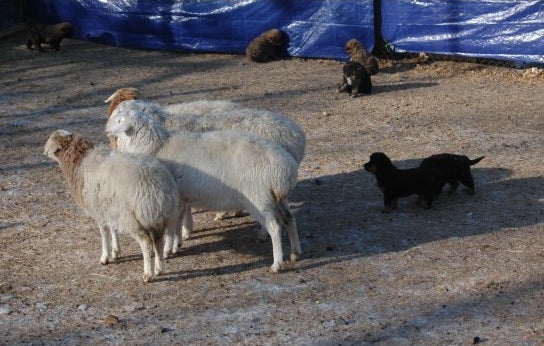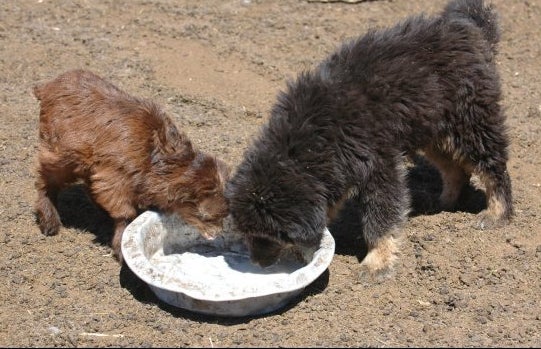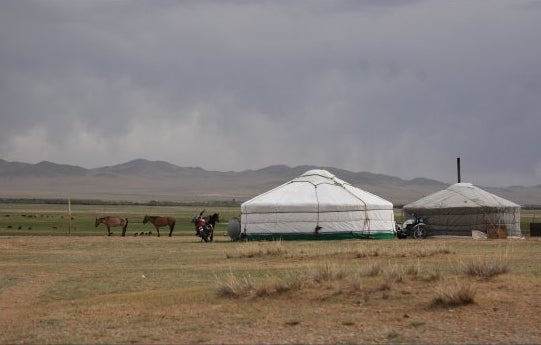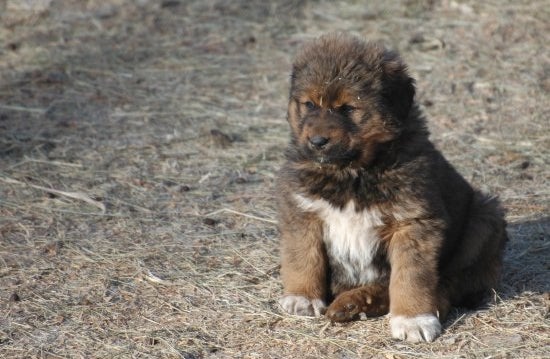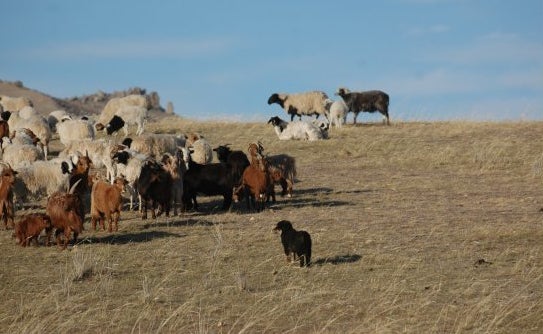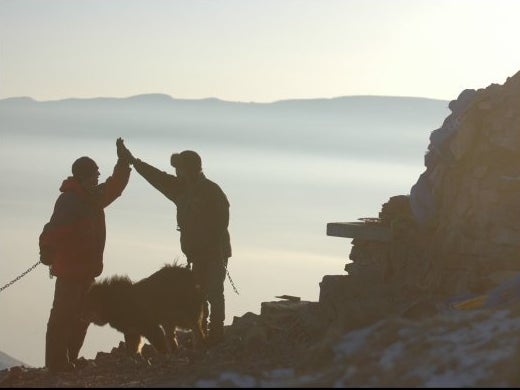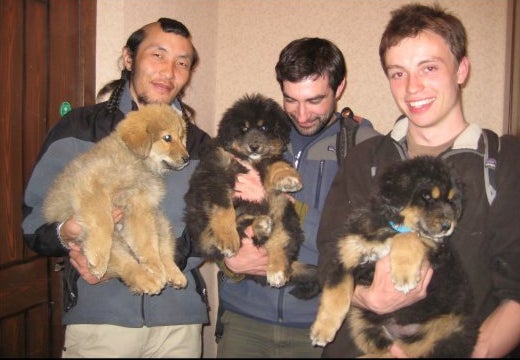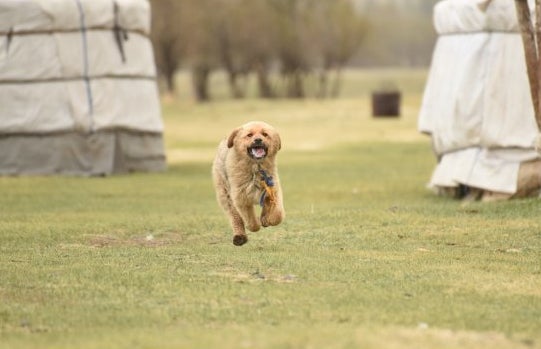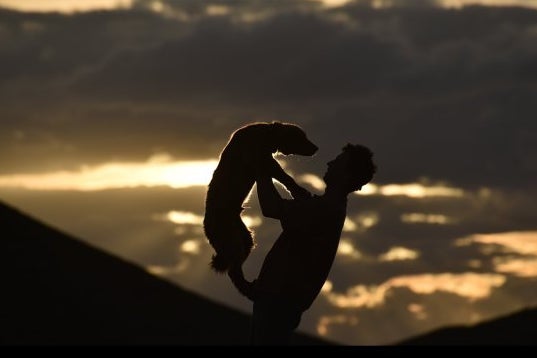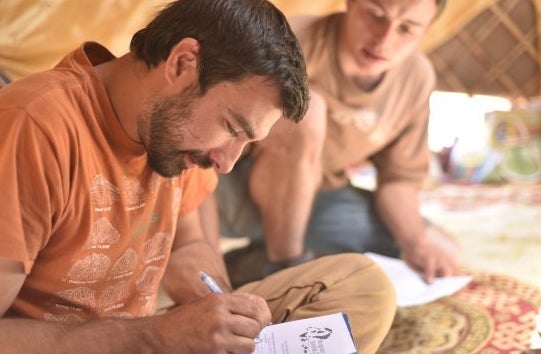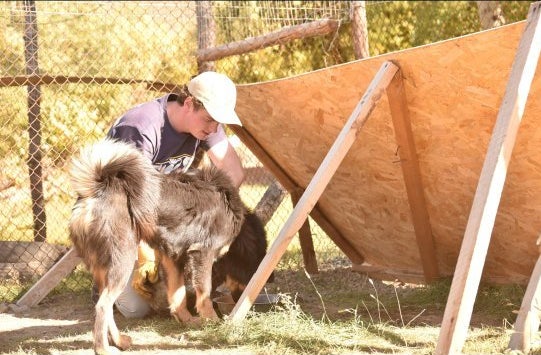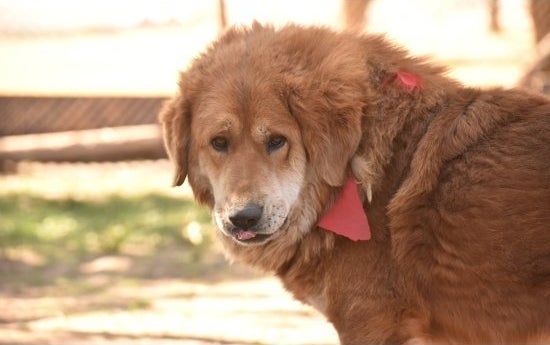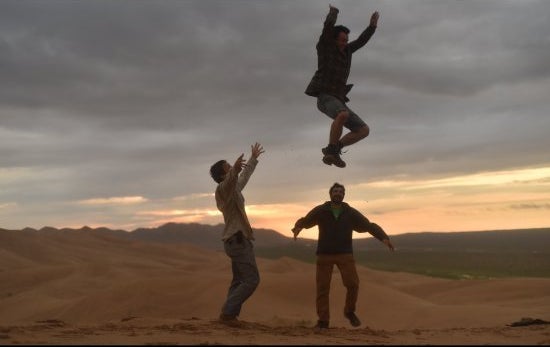The Mongolian Bankhar Dog Project, is a non-profit, non-governmental, conservation organization registered in Mongolia since October 2014. The organization built the first livestock guardian breeding and training facility in Mongolia. The concept is unlikely: raise dogs to protect sheep to save wolves and snow leopards. In fact, this is an ancient and effective method to guard livestock.
The Nomadic Guardian Foundation initiated work in 2004 in the United States, by Bruce Elfstrom, a biologist. In 1998, after establishing Overland Experts, an off road driving school and logistics company, Bruce traveled to Mongolia frequently for work, where he saw first-hand the devastating realities of livestock predation; "I was amazed, one evening a family lost 7 colt horses...". Eventually, Bruce and his partners raised private funding for the operational costs of the first year of the project.
The organization, specifically breeds and trains Bankhar dogs. Bankhar dogs are an ancient landrace, not a breed but a type of dog shaped through thousands of years of co-evolution with humans driven by the need for an effective guardian of livestock on the Mongolian steppe. Bankhar are large, athletic, protective, and need comparatively little food for their size. In practice, puppies form an early bond with the herd of sheep, goats and other livestock such as cows, horses and camels and they protect the herd for life from predators like snow leopards, and Mongolian gray wolves.
During the Soviet Occupation of Mongolia, from 1924 to 1990, this ancient tradition was lost, as were many other cultural norms and heritages. Under Soviet occupation, the structure of ownership of livestock was replaced with ownership by the state. Herders were forced into collectives, and trained as specialists to take care of specific areas of herding. Families also lost traditional grazing lands. By 1960, the majority of Mongolia's livestock and cultivated land had been collectivized. After the collapse of communism and departure of the Russians, herders in each collective divided up the animals and tried to reclaim their former grazing pastures; there were few of them at the time so the division worked to some extent.
In recent years, nomadic herder families of Mongolia have used these livestock guardian dogs less frequently as they are costly, and a target for theft. There have also been "modern" modifications in herding practice. For instance, some families are using motorcycles to herd sheep, instead of traditional horseback riders.
Without the dogs, the herds are vulnerable to predators, especially during the long winter. If there are attacks on the herd, it is not uncommon for the nomadic herders to hunt the predators. After all, their herd is their livelihood.
This type of hunting is defined as retribution killing for livestock loss, and is one of the main threats to the snow leopard, an endangered species. Mongolia is in fact, home to the second largest population of the species, following China. Snow leopards are highly adapted to their natural habitat in the cold high mountains and steppe of Central Asia. According to the World Wildlife Foundation (WWF), they number at fewer than 6,400.
The vulnerability of the snow leopard is compounded by the connotation of snow leopard fur as a luxury item, which makes snow leopards profitable to poachers. The poachers also trade hides, and bones. The recent boom in the mining economy of Mongolia, has also resulted in habitat loss for the animals. The habitat of the snow leopard is also threatened by changes in weather patterns, linked to climate change. These changes include more frequent occurrence of extreme weather hazards and patterns such as longer droughts, and colder winters.
In the first year of operation, the organization brought together 10 dogs. They bred 18 puppies who were given to screened nomadic herder families in Terelj National Park, one of the largest national parks east of the capital city, as well as Khustaii Nuruu National Park located southwest of the capital city, and Umungovi Province, located in the South Gobi. The idea is that, the Bankhar will protect the herd, and ward predators away, encouraging them towards hunting their favored wild prey, such as the ibex and Argali sheep, to decrease the likelihood of retribution killing. According to the WWF, the snow leopard keeps a balance in the ecosystem, because without them, there would be too many herbivores, which could overgraze the habitat, and leave no food for other wildlife.
Mongolia is in a particularly delicate situation today, as many nomadic families keep herds larger than ever before, numbering at over 1,000 animals for some, which contributes heavily to overgrazing and eventually desertification.
On the ground, three young men, Douglas Lally from New Jersey, USA and Soyolbold Serguleng, from the South Gobi of Mongolia, and Devin Byrne from Connecticut, USA have been the main actors in mobilizing the organization. Doug, who is the field coordinator of the NGO, arrived in Mongolia in January 2014 and had to find a translator fast. He joined the "Expats in Mongolia" Facebook group, with over 10,000 thousand members, and posted an advert. Soyolbold, who at the time was planning to take a break from his mining job and pursue his passion of photography saw this as a good opportunity to travel and decided to join in. He became the translator, and photographer for the project. Devin, heard of the project through word of mouth, and after completing high school decided to take a year off to travel and do some hands-on conservation work, before continuing his education at the University of Maine in wildlife ecology.
Their backgrounds are extremely different, but their calling has always been the same. Doug, completed a Bachelor of Arts history and philosophy degree at Fairleigh Dickinson University in 2009, and upon graduation pursued work that connected him to nature: fighting wild fires, for instance.
Soyolbold, pursued a degree in English Language at the National University of Mongolia, and upon graduation in 2010, pursued a well-paid and stable career in mining, while always maintaining his interest in wild life photography. Soyolbold witnessed the harsher winters, and severe droughts that have devastated the livelihood of many herder families in recent years, and catalyzed the transition from a nomadic lifestyle to urbanization. For Soyolbold, this is why he always wanted to work in conservation: to protect the environment, but also the nomadic way of life.
Devin, has traveled all across the states with his family, and ever since he was little, had dogs in his life. After finishing high school, he had a typical "I'm looking for a job that will take be anywhere but home" attitude, but never expected to end up in Mongolia. However, he explains he couldn't have asked for a better opportunity than to travel, train dogs and work in wild life conservation during his gap year between high school and university. For Devin, the unique nomadic culture, harsh environment, and recent economic growth made Mongolia an unpredictable, but extraordinary learning experience.
Together they built the dog breeding and training facility from the ground up. They chose the land together, and they built the fences, dog sheds, and kennels, with their own hands. The process of putting the facility together took nearly three months. Afterwards, they found dogs to breed across the country, in markets and with families. Their efforts came to fruition with 18 healthy puppies. At the facility, the puppies, were placed with herds of sheep at 3 to 4 weeks, to begin the bonding process as early as possible.
After nearly a year of hard work, Doug and Soyolbold sat with me to reflect on their efforts. For Doug, the organization not only gave him hands on experience in conservation work but, more importantly, gave him a glimpse into nomadic life and traditions. For instance, he explains to me how initially surprising it was that any person can visit any ger or nomads' home, and before anyone even knows why or how you got to be there, the family serve you tea and just talk. This open and warm spirited hospitality, he explains was just one of the many lessons the nomads unintentionally taught him.
For Soyolbold, the year of work came full circle when the team placed their first pup with a family in Umnugovi Province. After several months of discussion with a young herder family of six with over 1,000 animals, Doug, Soyolbold and Devin arranged the drop off. After driving 14 hours to the family's ger, they pulled up right next to the families herd. They then quickly took the puppy from the back seat of the truck and placed him near the sheep. They then ran, back to the car, and drove a few hundred meters away. With hand-held binoculars, they watched as the puppy darted back and forth between where the car was parked, and where the sheep were. For a few minutes, it was unclear whether the puppy would stay with the sheep, but in the end,it stayed. For this puppy to meander into the herd, Soyolbold explains, was the culmination of a year's hard work and marked a renewed optimism in the project. "It was a huge sigh of relief and a very emotional moment for us... I could see tears brimming in Doug's eyes".
Both agree that for the future continuation of this project, the organization must build stronger alliances with local organizations. Doug explains how some aspects of the project, such as finding homes for the puppies, were not as straightforward as the logic would imply, and were not so simple to implement. However, he clarifies that this is not a failure by any means, "but just means that for any project such as this, there must be continual readjustments". The NGO will look to deepen and open wider relationships with local partners as "this could really change the outcome of the project, because we found that how we present ourselves to the herders really matters. Allied with strong local forces, I think will facilitate more opportunities to collaborate with the herders, open dialogue and eventually lead to more optimistic outcomes".
As for Devin, who flew back to the States to begin university, his time in Mongolia invigorated his passion for nature and wild life. Working alongside the dogs, and having an opportunity to become a part of and learn from the nomadic herders, strengthened his passion for traveling and the environment. Devin was also surprised at, in the least densely populated of countries, "how many people I met and by how many of those people were friendly". His take away: "hospitality is quite different in Mongolia and I hope to take a bit of that home with me". Reflecting on the project, Devin explains that it has a long way to go before it can show some solid results. He explains, "It's hard work and takes a long time. If you look at what you've accomplished in a day you won't ever see a change. But when I look on the past year, it's astounding what we've done".
For Devin, it was his first time living in another country and he sums up his experience concisely: "when traveling you find that language is not much of a barrier, food is universal, and kids don't care what language you speak - they will laugh regardless".
All three young men explain that the hardest part of the project was in fact not playing with the puppies, which in turn, was also the best part. "They are just irresistible, especially when they are such social animals", explains Soyolbold, smiling.
Devin and Doug are now in the States and their successor is Greg Goodfellow. Greg completed an undergraduate degree in biology at Connecticut College in 2012 and has since been working in environmental conservation. He heard about this opportunity in Mongolia through a professor at Connecticut College, and was immediately interested in the opportunity. The allure of travel, hands-on fieldwork, and project management motivated him to take the job. Greg is looking forward to continuing the project, "now that we have Bankhar pups with herding families throughout Mongolia, we can start collecting data on the effectiveness of our 'puppy raising protocol' and on the ability of the Bankhar to reduce livestock predation. It's an exciting time to join the organization and I plan to take the Project to the next level."
To learn more about the project please visit Mongolian Bankhar Dog Project Facebook
